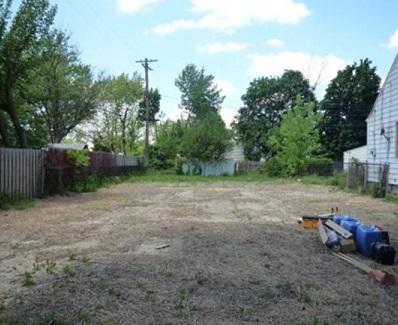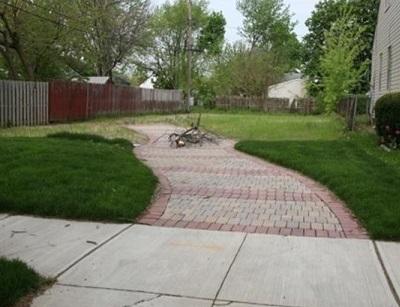EPA Science Matters Newsletter: Straightening the Road to Reuse - Connections between Demolition and Green Infrastructure
An EPA research hydrologist and partners are helping urban communities convert vacant lots into stormwater-absorbing green spaces.
 A vacant lot in Cleveland, Ohio
A vacant lot in Cleveland, OhioLike other urban centers, Cleveland, Ohio has been especially hard-hit by the loss of industrial jobs and the latest economic recession and housing crisis. As a result, the number of abandoned homes and vacant lots there have swelled into the tens of thousands.
EPA researchers are working with local communities in Cleveland and elsewhere to convert these abandoned former home sites into green spaces. Instead of symbols of urban decay, converted vacant lots can serve as centers for small-scale urban agriculture and places that absorb stormwater, collectively reducing sewer overflows and the amount of excess nutrients and other pollution flowing into local waterways. Oases among hardscrabble pavement and rooftops.
Agency research hydrologist Bill Shuster, Ph.D., helped lead studies conducted in Cleveland’s neighborhoods that explore how different demolition practices have affected vacant lots, particularly their ability to function in ways that enhance the local environment.
“We found that inconsistency in demolition practice is leading to poorly performing vacant lots that are not providing the environmental services they could be,” Dr. Shuster says. “I took field research findings, and asked: What can we do about this? How can we help cities incorporate vacant lots into their portfolio of green infrastructure?”
Dr. Shuster and his colleagues discovered (with a simple instrument called a dynamic penetrometer) that the land siting beneath vacant lots was often filled with buried debris or concrete pads left from former homes. At some sites, there was so much buried debris that researchers had to try up to ten different sampling points before they could get an acceptable soil core.
By gathering data on soil characteristics and hydrology across 52 different sites representing various eras of demolition treatments, along with modeling rainfall and runoff simulations, the team was able to determine what characteristics made the difference between a lot that would shed rainwater runoff, and one that would absorb it. For example, they determined that the condition of the soil—how much debris and whether it had any vegetative cover—plays a major role in the ability of the site to support green infrastructure, and that site conditions are a key component for judging a vacant lot’s reuse potential. (For more information on the importance of soil, see below: Evaluating Urban Soils.)
 Vacant lot after transformation to green space and permeable pavement.
Vacant lot after transformation to green space and permeable pavement.With such information, Dr. Shuster and his team identified a set of parameters important for turning vacant lots into environmental assets.
Officials at EPA’s regional offices for the upper Midwest (EPA Region 5) worked with Dr. Shuster to develop a kind of playbook for cities to use, a set of specifications for the bidding process and clear contract requirements for demolition companies hired to raze abandoned properties.
They concentrated on developing practices that do not significantly add to the cost of demolition. These include simple steps such as choosing soil appropriate for the local hydrological conditions when selecting fill soil for the lot; taking advantage of local construction recycling centers for used materials (instead of burying it onsite); and grading so that stormwater does not flow off of the site where it could reach the street and nearby storm sewer drains.
These standards are now being used in Cleveland and in Detroit, which is another city facing the challenge of a huge number of demolitions waiting to be done, and tens of thousands of undeveloped vacant lots.
By learning something about the nature of vacant lots, Dr. Shuster and his EPA research team and local partners are advancing the role of vacant lots as passive green infrastructure. Such innovation has the potential to create tens of thousands of small-scale water management centers scattered throughout older cities, helping them face the dual challenges of abandoned properties and aging, under capacity sewer systems. The overall impact will be felt well beyond improving inner cities.
Evaluating Urban Soils
As part of his work exploring how vacant, inner city lots impact stormwater management, EPA research hydrologist Bill Shuster, Ph.D. and partners developed a soil survey assessment protocol to identify the urban imprint on major types (“orders”) and hydrologic capacities. Unique information provided by following the protocol is helping communities and regions across the country understand the potential for soils to support certain green infrastructure applications.
In addition, the Agency has released a summary document Evaluation of Urban Soils: Suitability for Green Infrastructure or Urban Agriculture, a report providing concise, practical, and scientifically-based overview of the typical conditions of urban soils, together with recommendations on taking action to improve them to support green infrastructure or urban agriculture.
Learn More
- Hydrologist, Bill Shuster, Ph.D.
- This Science Matters story was developed, in part, on the following research:
- “Residential demolition and its impact on vacant lot hydrology: “Implications for the management of stormwater and sewer system overflows” Exit; Landscape and Urban Planning 125 (2014) 48–56. Accessed August, 2014.
- Evaluation of Urban Soils: Suitability for Green Infrastructure or Urban Agriculture (PDF)(26 pp, 3.3 MB, About PDF), U.S. EPA Publication No. 905R1103; December, 2011.
